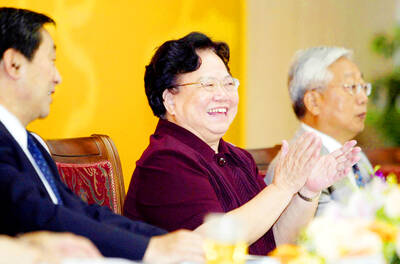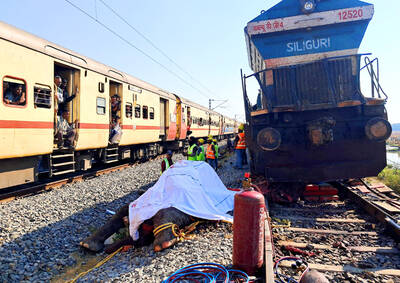Unidentified structures spotted by satellites on the borders of Xinjiang and Gansu Province, China, and posted on the Google Earth Internet service recently are giving rise to speculation about possible military activity, reports say.
The vast structures, all situated in parts of the Gobi used by China for its military, nuclear and space programs, have puzzled analysts. The imagery also leaves unanswered questions over whether the structures are dug in or painted.
Some of the sites observed are situated less than 160km from Jiuquan, where China’s space program and its launchpads are located. The Ding Xin military airbase, where China is believed to conduct classified aircraft tests, is 640km from some of the sites.
One picture taken in 2007 shows an aggregate of orange blocks the size of shipping containers arranged in a circle, with three military aircraft occupying the center. A more recent satellite sweep of the area shows the blocks scattered as far as 4.8km from the site.
Another image shows a series of metallic squares littered with what appears to be the debris of exploded vehicles, lending credibility to claims that some of the structures are used for gunnery or airstrike practice. Other structures consist of kilometers-long grids. With the Lop Nur nuclear test site located about 600km away from some of the structures, some experts have suggested the latter could be optical test ranges for missiles simulating the street grids of cities, with some speculating that this could be a replica of a Washington street layout. Others posit that the grids could be used for satellite calibration.
A defense expert at Jane’s Defence Weekly told the Telegraph that the structures looked similar to the kind of missile test ranges seen in the US, with target and instrumentation used to analyze the effect of missile blasts.
Beijing has yet to comment on the purpose of the structures.

REVENGE: Trump said he had the support of the Syrian government for the strikes, which took place in response to an Islamic State attack on US soldiers last week The US launched large-scale airstrikes on more than 70 targets across Syria, the Pentagon said on Friday, fulfilling US President Donald Trump’s vow to strike back after the killing of two US soldiers. “This is not the beginning of a war — it is a declaration of vengeance,” US Secretary of Defense Pete Hegseth wrote on social media. “Today, we hunted and we killed our enemies. Lots of them. And we will continue.” The US Central Command said that fighter jets, attack helicopters and artillery targeted ISIS infrastructure and weapon sites. “All terrorists who are evil enough to attack Americans are hereby warned

The death of a former head of China’s one-child policy has been met not by tributes, but by castigation of the abandoned policy on social media this week. State media praised Peng Peiyun (彭珮雲), former head of China’s National Family Planning Commission from 1988 to 1998, as “an outstanding leader” in her work related to women and children. The reaction on Chinese social media to Peng’s death in Beijing on Sunday, just shy of her 96th birthday, was less positive. “Those children who were lost, naked, are waiting for you over there” in the afterlife, one person posted on China’s Sina Weibo platform. China’s

‘POLITICAL LOYALTY’: The move breaks with decades of precedent among US administrations, which have tended to leave career ambassadors in their posts US President Donald Trump’s administration has ordered dozens of US ambassadors to step down, people familiar with the matter said, a precedent-breaking recall that would leave embassies abroad without US Senate-confirmed leadership. The envoys, career diplomats who were almost all named to their jobs under former US president Joe Biden, were told over the phone in the past few days they needed to depart in the next few weeks, the people said. They would not be fired, but finding new roles would be a challenge given that many are far along in their careers and opportunities for senior diplomats can

Seven wild Asiatic elephants were killed and a calf was injured when a high-speed passenger train collided with a herd crossing the tracks in India’s northeastern state of Assam early yesterday, local authorities said. The train driver spotted the herd of about 100 elephants and used the emergency brakes, but the train still hit some of the animals, Indian Railways spokesman Kapinjal Kishore Sharma told reporters. Five train coaches and the engine derailed following the impact, but there were no human casualties, Sharma said. Veterinarians carried out autopsies on the dead elephants, which were to be buried later in the day. The accident site